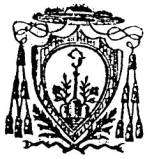Sylvestrines

The Sylvestrines are a congregation of monks of the Order of St. Benedict who form the Sylvestrine Congregation. The Sylvestrines use the post-nominal initials O.S.B. Silv.[1] The congregation was founded in 1231 by Saint Sylvester Gozzolini. They are members of the Benedictine Confederation. Unlike most other congregations of the Order, they do not have any monasteries of nuns. The congregation is similar to others of eremetical origin, in that their houses are not raised to the status of an abbey, which would entangle the monasteries more strongly in the affairs of the world. The congregation, though, is led by an abbot general, the only abbot it has, who supervises all the houses of the congregation.
History
The founder, Saint Sylvester (1177-1267), was born at Osimo near Ancona, Italy. As a young man he entered a community of Augustinian canons regular, who served the cathedral, and eventually was professed in that Order and received Holy Orders. About 1227 he left the community to lead an austere, eremitical life. Disciples flocked to him, however, and in 1231 he built a hermitage by the mountain of Montefano in the March of Ancona (now the town of Fabriano), from which the community took its original name.[2]
The community that Sylvester founded followed the Rule of St. Benedict, but, as regards poverty in external matters, was far stricter than the general Benedictines of the time. The congregation was approved in 1247 by Pope Innocent IV, and, at Sylvester's death in 1267, there were eleven Sylvestrine monasteries.[2] At their peak, there were 56 monasteries in the congregation, mostly in Umbria and Tuscany, as well as in the March of Ancona.
Like all religious communities in Europe, the Sylvestrines suffered throughout the 19th century from the upheavals of the French Revolutionary Army and the later unification of Italy. By 1907 there were only nine Sylvestrine communities, the principal one being in Rome, the Monastery of St. Stephen the Protomartyr, which was founded in 1563 to serve as the motherhouse of the congregation.[3] The community there had about 60 choir monks at that time. As of 2010, there are only three monasteries still functioning in Italy.
Sylvestrine saints include the founder, Sylvester Gozzolini, St. Bonfilius, Bl. Giovanni del Bastonne, and the Bl. Giuseppe and Ugo di Serra San Quirico.[2]
Expansion
For most of its history, the Congregation was confined to Italy. The Ceylon Mission was begun in 1845,[4] their first foundation outside Europe. The Sylvestrines provided many of the clergy for that missionary diocese well into the 20th century. Additionally, they have monasteries in the United States, the first being established in Atchison, Kansas, where two monks arrived in 1910 and served the spiritual needs of the many workers in the coal industry there. As that industry faded and the local population began to move away, they looked elsewhere to build a permanent home. They were welcomed into the Archdiocese of Detroit in 1928, where they built their first monastery in the country in 1938, now called St. Benedict of Oxford Priory.[5] They have a daughter house in Clifton, New Jersey, which serves as a shrine to the Holy Face of Jesus, a devotion long connected to the congregation.[6]
A conventual priory was founded in 1962 in Australia at Arcadia, Sydney, by an Italian monk serving in Sri Lanka. There are now also monasteries in India.[7] In the late 20th century, a foundation was set up in the Philippines[8] and, more recently, in the Democratic Republic of the Congo.[9]
In September 2007 Dom Michael Kelly, O.S.B., a monk of the Australian monastery, was elected as the 115th abbot general of the congregation. He has served in that position for twelve years and resides at the motherhouse in Rome.
Distinctions
The Sylvestrine monks operated as a completely autonomous congregation for most of their history, until they joined the Benedictine Confederation in the mid-20th century. This placed the congregation under the general supervision of the abbot primate of the Benedictine Order, and joined them to the life of the entire Order throughout the world.
One distinguishing mark of the Sylvestrines continues to be that their habit is dark blue, as opposed to the standard black worn by most other Benedictines. Additionally, they distinguish themselves from other Benedictines by adding the abbreviation "Silv." after the standard postnominal initials of the Order, O.S.B. Since they joined the Benedictine Confederation, however, that practice is seldom followed.
References
- ↑ "Sylvestrine Congregation of the Benedictine Order (O.S.B. Silv.) - Sylvestrines" GCatholic.org. Gabriel Chow. Retrieved June 20, 2016
- 1 2 3 Webster, Douglas Raymund. "Sylvestrines." The Catholic Encyclopedia. Vol. 14. New York: Robert Appleton Company, 1912. 30 Jan. 2014
- ↑ Congregazione Benedettina Silvestrina "Curia Generalizia" (Italian)
- ↑ Navajeevan Silvestro-Benedictine Monastery, Vijayawada, India
- ↑ St. Benedict of Oxford Priory "History"
- ↑ Holy Face Monastery website
- ↑ Indian Christian Community website
- ↑ "Address of Pope John Paul II to the Sylvestrine Benedictines" (2001)
- ↑ St. Benedict's Monastery, Arcadia "Community News"
Sources
| Wikimedia Commons has media related to Sylvestrines. |
 This article incorporates text from a publication now in the public domain: Chisholm, Hugh, ed. (1911). "Sylvestrines". Encyclopædia Britannica (11th ed.). Cambridge University Press. This work in turn cites:
This article incorporates text from a publication now in the public domain: Chisholm, Hugh, ed. (1911). "Sylvestrines". Encyclopædia Britannica (11th ed.). Cambridge University Press. This work in turn cites:
- Hippolyte Hélyot, T.O.R., 1718. Histoire des ordres religieux, vi. c. 21
- Heimbucher, Max, 1907. Orden und Kongregationen, i. 30
- Wetzer und Welte, nd. Kirchenlexicon, 2nd ed.
 Herbermann, Charles, ed. (1913). "Sylvestrines". Catholic Encyclopedia. New York: Robert Appleton Company.
Herbermann, Charles, ed. (1913). "Sylvestrines". Catholic Encyclopedia. New York: Robert Appleton Company.